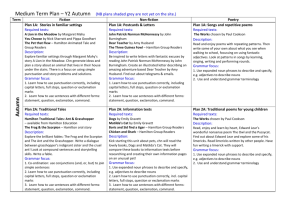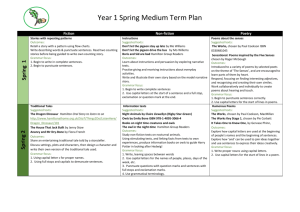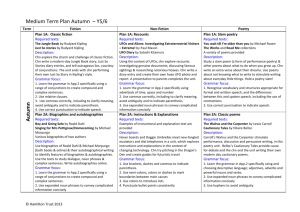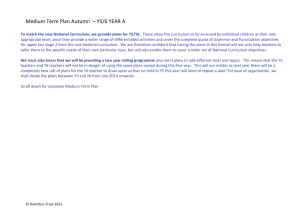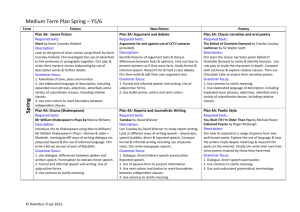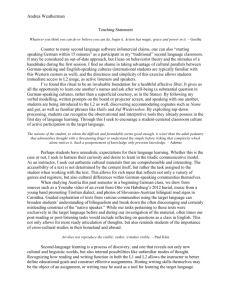Medium Term Plan
advertisement
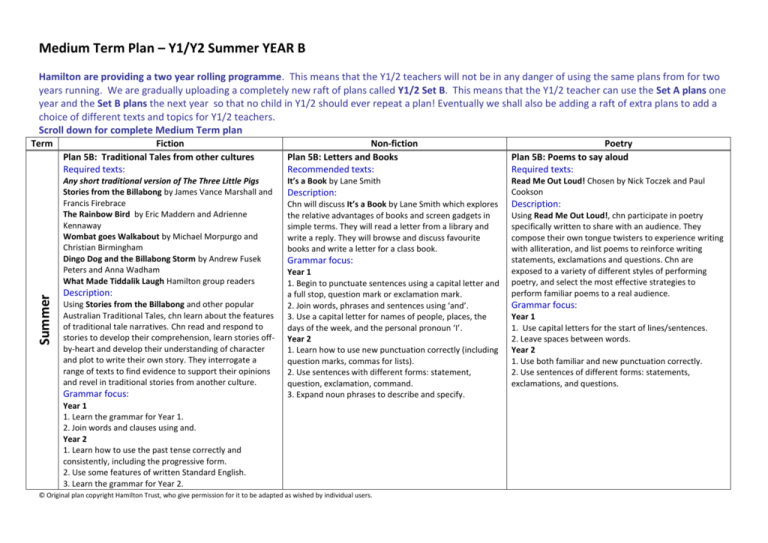
Medium Term Plan – Y1/Y2 Summer YEAR B Hamilton are providing a two year rolling programme. This means that the Y1/2 teachers will not be in any danger of using the same plans from for two years running. We are gradually uploading a completely new raft of plans called Y1/2 Set B. This means that the Y1/2 teacher can use the Set A plans one year and the Set B plans the next year so that no child in Y1/2 should ever repeat a plan! Eventually we shall also be adding a raft of extra plans to add a choice of different texts and topics for Y1/2 teachers. Scroll down for complete Medium Term plan Summer Term Fiction Plan 5B: Traditional Tales from other cultures Required texts: Non-fiction Plan 5B: Letters and Books Recommended texts: Poetry Plan 5B: Poems to say aloud Required texts: Any short traditional version of The Three Little Pigs Stories from the Billabong by James Vance Marshall and Francis Firebrace The Rainbow Bird by Eric Maddern and Adrienne Kennaway Wombat goes Walkabout by Michael Morpurgo and Christian Birmingham Dingo Dog and the Billabong Storm by Andrew Fusek Peters and Anna Wadham What Made Tiddalik Laugh Hamilton group readers It’s a Book by Lane Smith Read Me Out Loud! Chosen by Nick Toczek and Paul Cookson Description: Using Stories from the Billabong and other popular Australian Traditional Tales, chn learn about the features of traditional tale narratives. Chn read and respond to stories to develop their comprehension, learn stories offby-heart and develop their understanding of character and plot to write their own story. They interrogate a range of texts to find evidence to support their opinions and revel in traditional stories from another culture. Grammar focus: Description: Chn will discuss It’s a Book by Lane Smith which explores the relative advantages of books and screen gadgets in simple terms. They will read a letter from a library and write a reply. They will browse and discuss favourite books and write a letter for a class book. Grammar focus: Year 1 1. Begin to punctuate sentences using a capital letter and a full stop, question mark or exclamation mark. 2. Join words, phrases and sentences using ‘and’. 3. Use a capital letter for names of people, places, the days of the week, and the personal pronoun ‘I’. Year 2 1. Learn how to use new punctuation correctly (including question marks, commas for lists). 2. Use sentences with different forms: statement, question, exclamation, command. 3. Expand noun phrases to describe and specify. Year 1 1. Learn the grammar for Year 1. 2. Join words and clauses using and. Year 2 1. Learn how to use the past tense correctly and consistently, including the progressive form. 2. Use some features of written Standard English. 3. Learn the grammar for Year 2. © Original plan copyright Hamilton Trust, who give permission for it to be adapted as wished by individual users. Description: Using Read Me Out Loud!, chn participate in poetry specifically written to share with an audience. They compose their own tongue twisters to experience writing with alliteration, and list poems to reinforce writing statements, exclamations and questions. Chn are exposed to a variety of different styles of performing poetry, and select the most effective strategies to perform familiar poems to a real audience. Grammar focus: Year 1 1. Use capital letters for the start of lines/sentences. 2. Leave spaces between words. Year 2 1. Use both familiar and new punctuation correctly. 2. Use sentences of different forms: statements, exclamations, and questions. Plan 6B: Humorous stories Required texts: Plan 6B: Information Texts - Owls Required texts: Plan 6B: Poems by the same author - Milligan Required texts: Chicken’s Bad Dream Hamilton Group Readers Boris and Sid Go Camping Hamilton Group Readers Alexander and the Terrible, Horrible, No Good, Very Bad Day by Judith Viorst Traction Man is Here by Mini Grey Traction Man meets Turbo Dog by Mini Grey Owl Babies by Martin Waddel Owls (Usborne Beginners) by Emily Bone Dusk until Dawn by Martin Bradley The Owl and the Night Hamilton Group Readers A Children’s Treasury of Milligan by Spike Milligan Description: Explore the humour in Alexander and the Terrible, Horrible, No Good, Very Bad Day and share ideas about what sometimes gets the chn’s day off to a bad start. Then read Traction Man is Here and enjoy his adventures, again looking at the humour. Chn will then plan and write their own version of the story. Chn will learn about information texts by exploring exciting facts about owls. They start with Owl Babies and then look at the structure of non-fiction in Usborne First Reading - Owls. Next they make a quiz using the information texts to support this. After this, they focus on Barn Owls and read From Dusk to Dawn. Finally they make an owl poster using some of the key feature of information texts. Grammar focus: Grammar focus: Year 1 1. Punctuate sentences using a capital letter and a full stop, a question or exclamation mark. Year 2 1. Learn how to use the past tense correctly and consistently, including the progressive form. 2. Use sentences with different forms: statement, question, exclamation, etc. 3. Use subordination (using when, if, that, or because) and coordination (using or, and, or but). Year 1 1. Begin to punctuate sentences using a capital letter and a full stop, question mark or exclamation mark. 2. Learn the grammar for Year 1. Year 2 1. Use sentences with different forms: statement, question, exclamation, command. 2. Learn the grammar for Year 2. Description: © Original plan copyright Hamilton Trust, who give permission for it to be adapted as wished by individual users. Description: Spike Milligan is one of the nations’ favourite poets and during this unit the chn will have the full fun Milligan experience! They will learn poems by heart; extend Today I saw a Little Worm using rhyming words and invent their very own fantasy creature using Hipprhiinostricow as their inspiration. Grammar focus: Year 1 1. Use a capital letter for the personal pronoun. 2. Leave spaces between words. Year 2 1. Learn how to use punctuation, including full stops, capital letters, exclamation marks and apostrophes for contracted forms. 2. Use expanded noun phrases to describe and specify.
